Picture of the Future
This article is for advanced Business Designers, who want to bring their Business Design projects to a more ambitious level. We consider a tangible and aligned "Picture of the Future" as one of the most important ingredients and pre-requisites for successful Business Design projects. We want to shed light into the questions what a "Picture of the Future" looks like and why it is so important for innovation projects.
Bernhard Doll
Business Design Maverick
Tim Müller
Co-Author

Uwe Pelger
Business Design Maverick

David Mooz
UX & Business Designer

Dominik Kaiser
Sustainability Expert
Published by Business Design Network.
Content
1. What Picture...and why?
At the end of the day, Business Design can't work if the management of an organisation has no clear picture of what customers and their own organisation should look like in the future. Again, it won't work! But most companies have a vision, a strategy and at least some financial and sustainability goals, haven't they? The initial reaction of some managers to the question of whether they have a clear vision or "Picture of the Future" for the organisation they are accountable for is:
Sure! We want to become the Nr. 1 in our industry XYZ and increase our gross margin by 3%.
Well, this is neither a "Picture of the Future" nor a strategy. It is a goal. And by the way, terms such as "purpose", "vision", "mission", "strategy", "goals", "KPIs" etc. are often mixed up and create more confusion than clear guidance. Also buzzwords such as "digitalisation", "sustainability"1, "customer centricity" are a good starting point but not precise enough that they provide any guidance for innovation activities and management decisions around these activities. And this misconception is prevalent in many companies. What we need instead is a "picture" of what the "life" of customers and a company may look like in the future. And this picture needs to be as tangible and visual as possible that employees of an organisation are able to grasp it and organise themselves. Why is such a "picture" so important? If your vision of the future is vague and more a goal than a concrete idea of your future you want to build, pretty much everything you do in managing innovation will be difficult. Hence, a picture of the future is a very essential leadership tool for modern managers across industries.
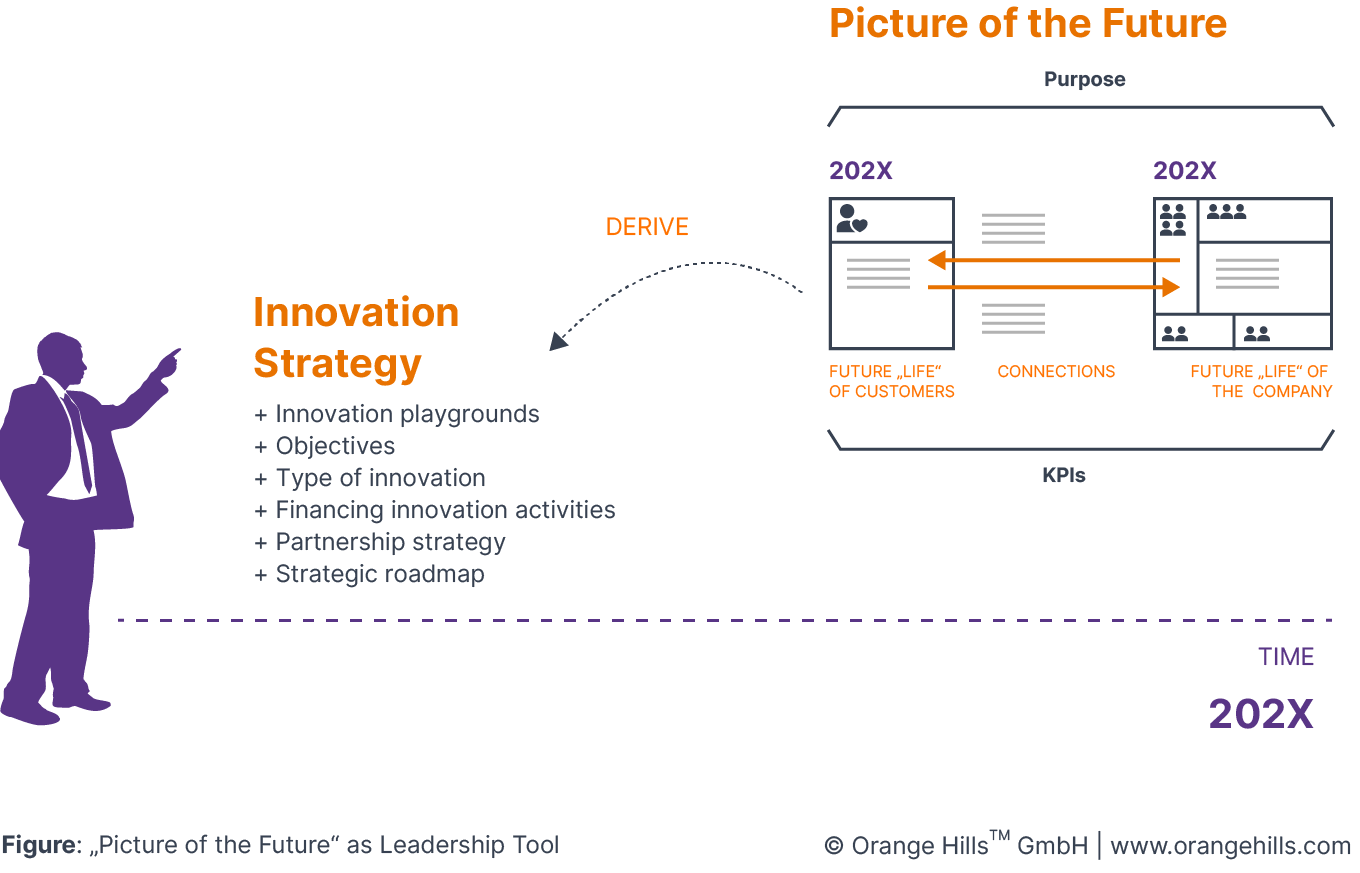
Without a picture of the future, you will have challenges to derive your "innovation playgrounds" and eventually an idea or innovation portfolio. You will also get vague decisions at the end of a Business Design sprint and never 100% commitment for new ideas. You won't get the best people for a project team. Managers will always rely on numbers and business cases to make decisions in the context of innovation. It will be difficult to kill a bad project, because nobody knows what "bad" really means. Nothing is really good, nothing is really bad. And it is even worse for us: You need to have very sharp senses to realise that the missing vision is the reason for all that. Because everyone tells you the opposite ("sure, we have a strategy!").
Keep in mind that a "Picture of the Future" usually encompasses "old" elements from today's core business as well as new and more disruptive elements with a dual strategy to embrace this ambidexterity.
We don't need a "perfect" map of the future. The details of the picture will be wrong anyway. But what is the point then? The goal of this exercise is not to precisely predict the future, but to support everyone in an organisation to make big and small decisions today in an aligned manner. This may impact your hiring process. This may impact which ideas will be prioritised. This may impact how sponsors of a Business Design sprints guides new innovation projects.
A "Picture of the Future" is barely driven by pains and challenges your customers experience today. Your vision should be driven by an entrepreneurial idea what kind of future YOU want to build with your company. Sounds scary? It shouldn't and, by the way, your picture of the future can be revisited and revised over the years. Be brave!
2. Key Components
So let's build your "Picture". A good way to visualise a "Picture of the Future" that truly enables us in the innovation space consists of six aspects:
The purpose of your organisation: This part of a Picture of the Future gives the reason why a company is still relevant in the future. Relevant to customers, to the society, to employees and to partners and it fits to sustainability targets in alignment to the Paris Agreement.
The future "life" of your customers: This part depicts the future life of customers in all details. It should give a clear idea how the life of customers may change to identify implications.
The future "life" of your organisation: The "counterpart" of 2 but not necessarily a reaction of 2, since we strive to design the future. this part gives a grid impression how a company may create value for customers ind the future.
The connections between 2. and 3.: This part may include the line up of future products and services, relationships to customers, sales and marketing approaches.
The future context of your organisation: Every company is embedded into a social, technological, economic, environmental and political context. We try at least to highlight a couple of aspects that may impact the evolvement of customers and our organisation in the future.
Ways to measure success (metrics e.g. KPIs + OKRs): Yes, measuring success will still be relevant in the future. We will keep doing this and find suitable measures for both worlds: Optimisation and exploration.
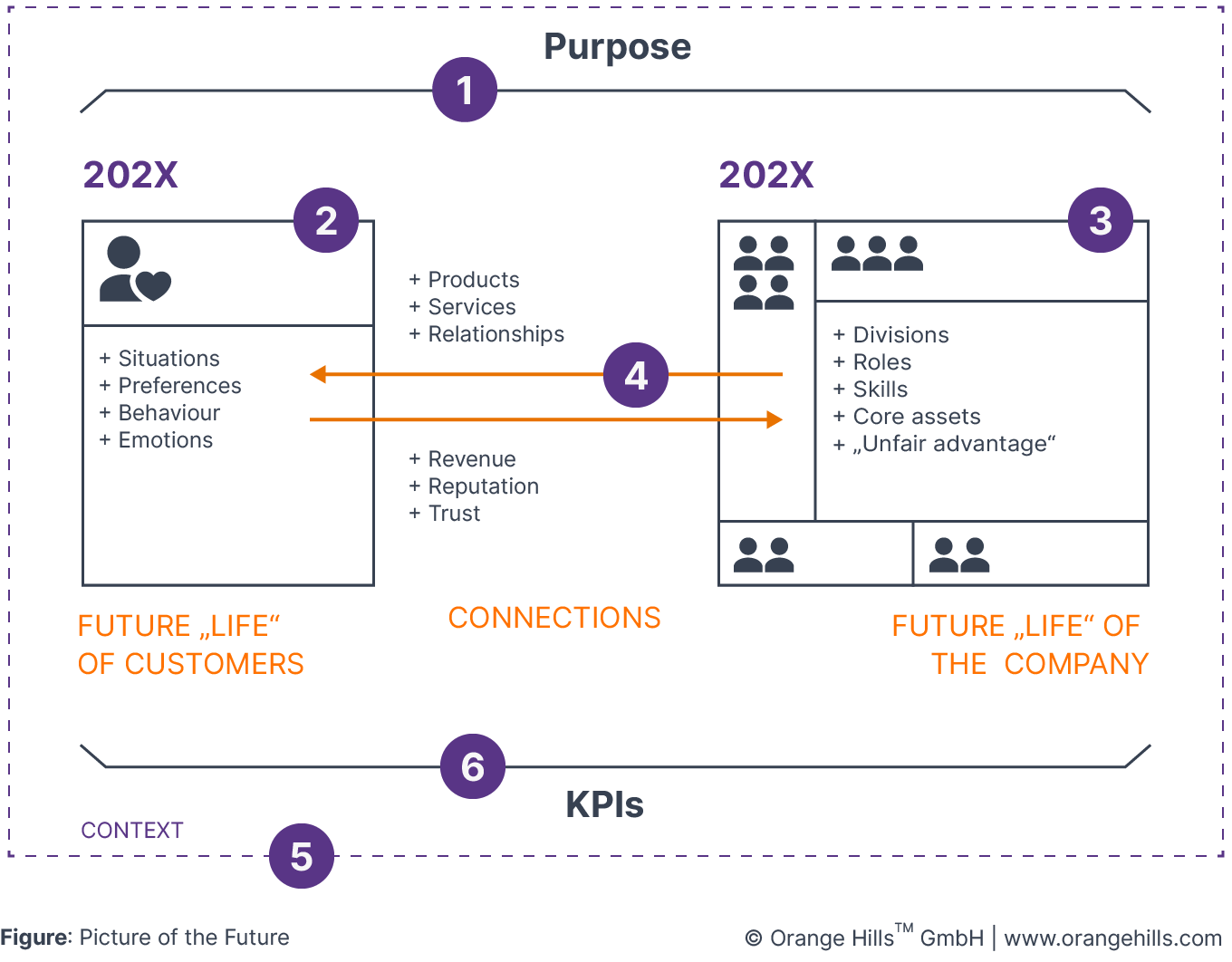
Here is a list of questions we love to ask as a starting point in order build a "Picture of the Future":
Purpose of your organisation
Why will your organisation still exist in the future?
What are the most relevant playgrounds in the future?
What do you want to be famous for?
"Life" of your customers
"Who do you want your customers to become?" (see book from Michael Schrage)
How will customers live and work in the future?
How many customers are potentially available in key markets?
"Life" of your organisation
Who (= role) will be sitting in your organisation and what will they be doing all day long?
What will be your "core assets" and "unfair advantage" in the future?
What do you need to "unlearn" in order to build our sustainable future?
We know that finding answers to these questions is difficult and the answers may change over time. That's the way it is. But it is absolutely essential as a leader to have answers to these questions in order to steer the organisation, decide and prioritise. Visualising your answers to these questions in a visual format (mind map, video, LEGO Serious Play, visual illustration) can be a good idea, but is not always necessary. Running a couple of Business Design projects is a great way to shed light into the questions above and find brutally honest answers where you are today and where you should be tomorrow.
Try consider the famous quote from the famous sociologist Karl E. Weick in the context of your strategy process: "An organisation can never know what it thinks or wants until it sees what it does."
Well, we think this statement is true but a bit too extreme. You can imagine the future (top down) but always need to consider what your organisation is capable of doing in reality (bottom up).
3. Stakeholders & Mind-set
Many people are typically involved in the design and execution of a "Picture of the Future". In this paragraph, we highlight the most important roles and and what challenges they may encounter:
Top management: Senior leaders usually initiate the "Picture of the Future" development process. Their obvious role is usually to shape an entrepreneurial idea for the entire organisation and make decision on a daily basis to execute the vision. This may be easy right after the workshop but tricky to preserve the momentum and rigour for weeks and months to come. In addition, many managers still lead companies with a simple set of KPIs rather than an "idea". The problem is the word "manager" in contrast to a "leader" or "entrepreneur".
Middle management: Middle managers are the once who translate the strategy into clear actions. They need a very good briefing from top management and should be partly involved in the development process of a "Picture of the Future". Nevertheless, they often show a reserved engagement in shaping and executing a "Picture of the Future" and the corresponding transformation process. Some managers simply fear a loss of power, and expect new uncertainties that are not always good for a corporate career path. And these emotions are not baseless: It often happens that functional roles of middle managers can change drastically when a new "Picture of the Future" is on the table.
Employees: Colleagues in explore and core areas often welcome a concrete strategic guidance that helps them structure their daily work. They bring the vision to life and often show a way higher intrinsic motivation. But employees should get support in the practical translation process from the vision to their desks or workbenches. This can happen with interactive worships or trainings, regular feedback sessions, exchange formats with their functional peers etc. Also a proper documentation as a "playbook" incl. "from-to" statements for certain organisational roles may support the transformation process.
4. Development Process
A "Picture of the Future" can be build in many ways. Basically, we distinguish between two distinct perspectives to tackle this:
Top down: You hire a traditional management consultancy to run a strategy project resulting in 50-200 Powerpoint slides with an impressive analysis of mega trends, market dynamics, promising customer segments, capabilities of your organisation incl. SWOT analysis and, of course, a list of recommendations for you organisation etc. Based on theses insights you build your "Picture of the Future".
Bottom up: You run a couple of challenging innovation projects with Business Design for selected "lead users", in best case, at the edge of your comfort zone to learn under real conditions what "lead users" really anticipate, how pretty new technology really works and what your organisation is capable of doing in the far-stretched innovation space...and what it is not.
Well, the combination of both perspectives entails a certain sort of magic. Define strategic guiding principles "top down" and then bring them to life with real life projects "bottom up", learn and continuously adapt your principles along the way. Before we design the development process for a "Picture of the Future", we need to understand the challenge behind. In practice, we often see the following two types:
Synchronisation: The leaders do have individual "Pictures" of the future of a company, but they are not aligned across all board members and employees. The approach here is to align these individual pictures and create a shared perspective. This case is comparatively easy to solve.
Inspiration: The leaders lack a clear picture and (sometimes) don't see a benefit in having such a picture. They perceive themselves as an administrator of the status quo and manage their company based on KPIs. In this case, an important step in the development processes is to provide decent inspiration about the future of the industry, direct and indirect competitors, new technologies and the voice of customers before we start building a "Picture of the Future".
Typical phases of such a development process are:
Setting the space: We usually have 1:1 interviews with everyone participating in the development process. We explain the idea behind a "Picture of the Future" as a modern leadership tool and clarify expectations. We also try to get a sense of existing individual perceptions on the future of the company, since this will have a tremendous impact on the design of the next phases in the development process.
Inspiring research / foresight: Depending on the challenging the process is trying to tackle (synchronisation versus inspiration, see above), it is required to provide inspirational research results that help leaders create their own perspective on what the future of the given context might look like. This may include stories around competitors' initiatives, what customers think and believe about their future, new technologies or regulations that might affect the business of the future etc.
Defining future scenarios and visualisation (iterative process): In 2-3x workshop sessions, participants of the development process will be confronted with a range of questions around the future "life" of customers, of the organisation etc. (see above). The answers will be captured and after each session, a specially-trained PotF Designers joins the conversation, listens to the story and drafts a first or the next version of the "Picture of the Future". The current version of the picture is always subject to change.
Final documentation & storytelling: The "Picture of the Future" will be often documented in a playbook (Powerpoint, Miro, Wiki) including audio and video explanations of someone walking through the picture and explaining key elements as a compelling story.
Roadmap & next steps: And finally, every development process ends with the definition of so called "playgrounds" (see below) for next innovation initiatives and projects mapped on a timeline with resource and budget planning.
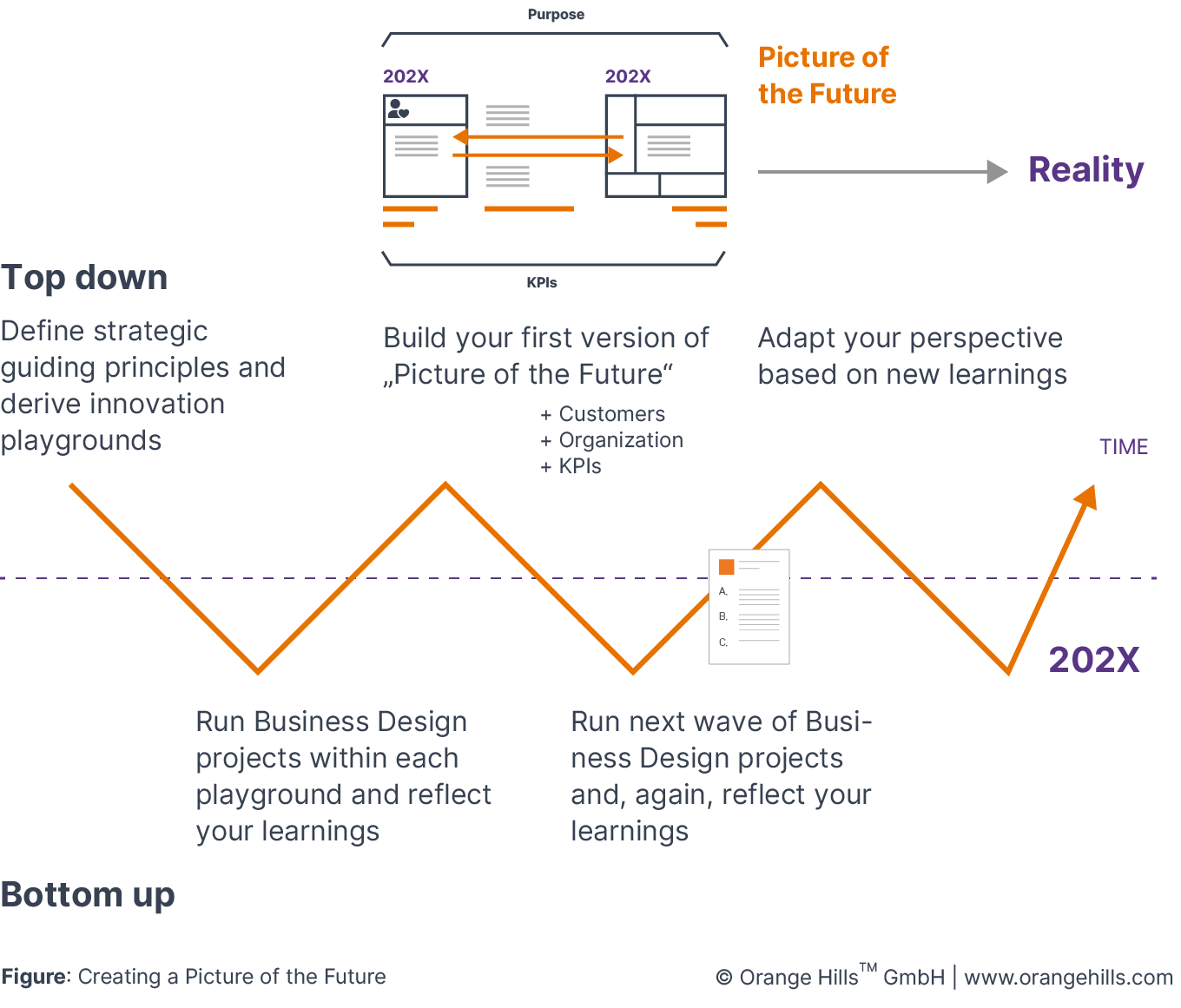
The illustration above shows how Business Design projects can be embedded into a strategy-building process to find reliable and authentic answers to the questions before. Based on the learnings from running Business Design projects, we unveil the "naked truth" about an organisation, specifically around the "What?" and "How?" question and help leaders of an organisation to even find answers to the "Why?" question. Then, building a tangible "Picture of the Future" with (usually financial and sustainable) KPIs is the logical next step.
5. Tools
Golden Circles
Answers to the questions before can be grouped and visualised with the so called "golden circles"- a term initially coined by Simon Sinek.
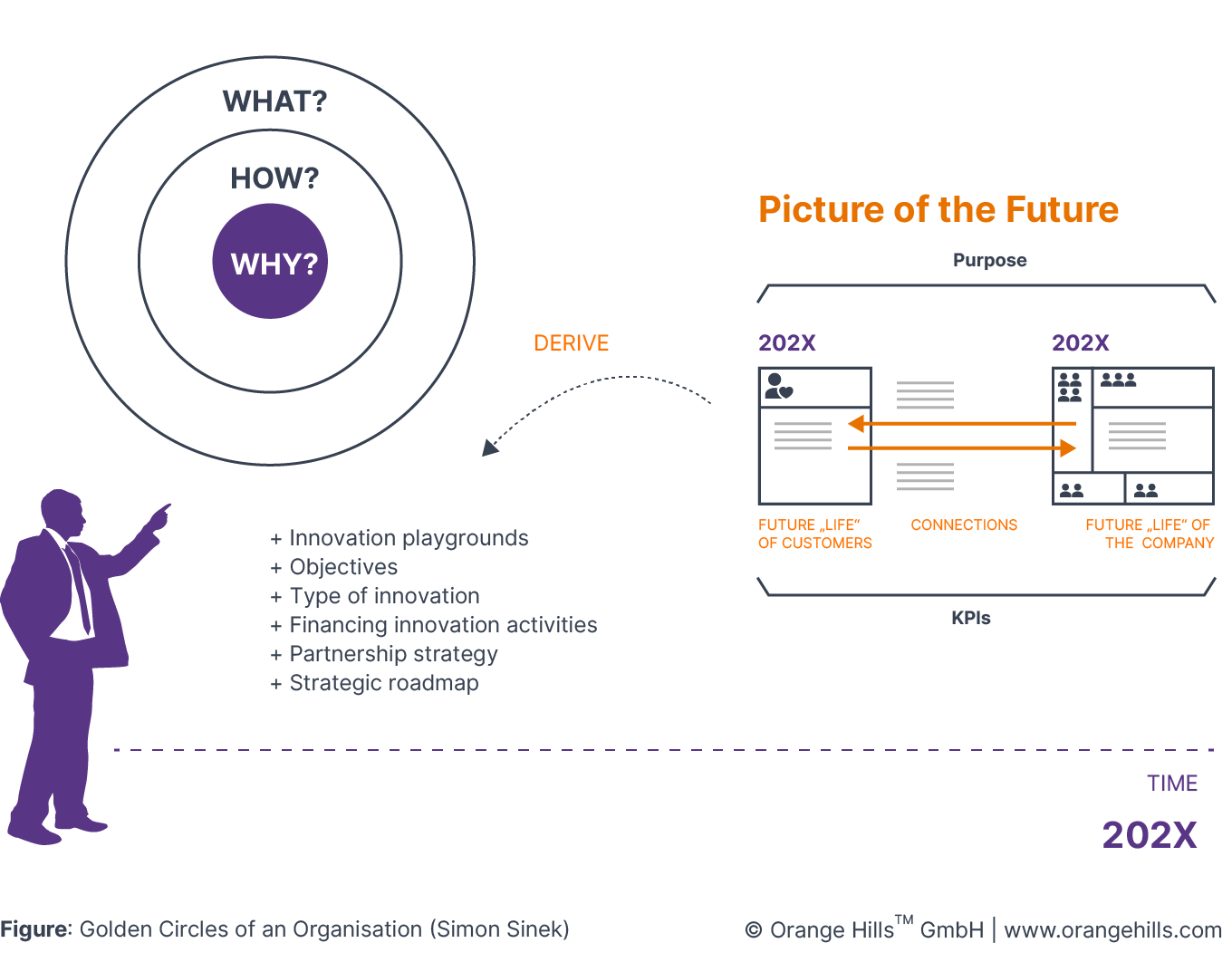
The "Why?" question refers to the purpose of an organisation, its beliefs and reason why the organisation exists and should exist in the future aAnd what is their value add for people and the planet. It is usually an emotional statement that makes employees or members of the organisation proud and 100% committed (see "purpose of your organisation").
The "How?" question links to the "secret sauce" how an organisation creates value for customers, partners and / or the society. This can be guiding principles, processes or special skills (see "life of your organisation").
The "What?" question is usually the easiest to figure out: The answer may include products and services an organisation sells or provides to the outside world (see "connections").
3D Toolbox
The 3D Toolbox is an effective communication tool to align different perceptions and get a common understanding of ideas and verbally expressed thoughts. To create these visualizations with the Toolbox in digital settings (when LEGO Serious Play is no option), we use the 3D Toolbox to translate words or workshop results into tangible images. The reasons are simple:
Using the 3D Toolbox allows us to visualize even abstract, complex or intangible aspects of an organization (e.g., culture, leadership style, quality of teamwork).
Building models with the 3D Toolbox enables a group of managers to create a shared understanding of their visions. Since the result of the creation process is a digital artifact, it can be adjusted and refined at any time.
Another critical success factor is the support of a competent Business Visualizer with a background in business design, business strategy development, and graphic design to use the 3D Toolbox. In creating the visualization, the visualizer not only acts as a translator from word/workshop result to image but also plays a crucial role in condensing the content to the essential elements of the "Picture of the Future" and significantly reduces the amount of iteration to finalize the picture (especially compared to a pure graphic artist).
Here is an example what a "Picture of the Future" in 3D may look like:
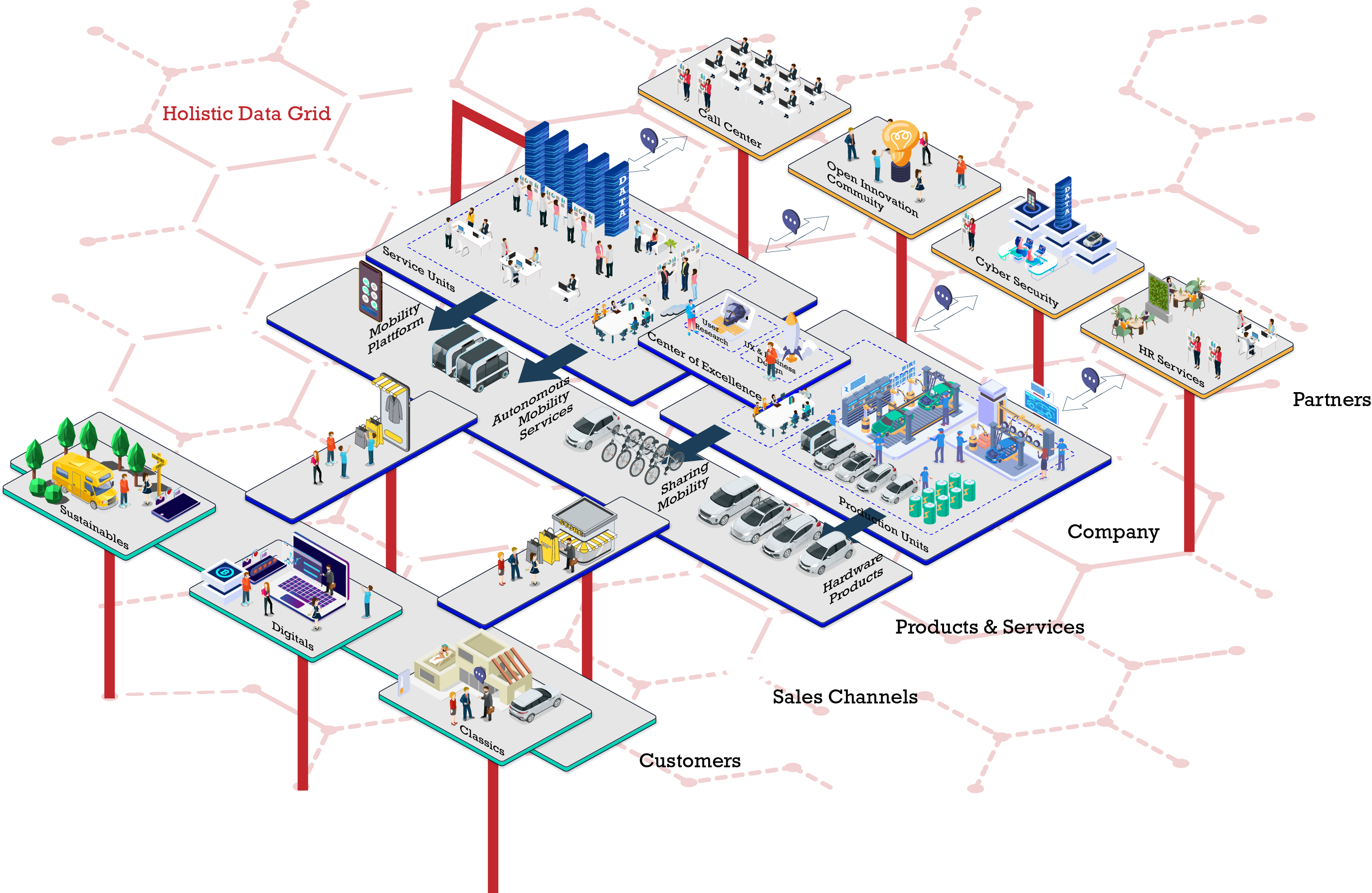
LEGO Serious Play
Modeling with LEGO bricks is a very powerful approach to develop aligned answers for tough and abstract questions in a highly diverse group of people. We use LEGO a lot to visualise a "Picture of the Future" of a company. The reasons are simple:
Using LEGO bricks allows us to visuals even abstract or intangible aspects of an organisation (e.g. culture, leadership style, quality of teamwork, social and environmental impact).
LEGO models can be a easily modified and almost refined in real-time in a workshop scenario. This is important when a group of managers create a shared understanding about their visions.
Building LEGO models doesn't require any special training. Fiddling with bricks is what many of us know from their childhood.
Building LEGO models doesn't need special infrastructure or premises. It just works in any kind of office space. You just need a BIG table.
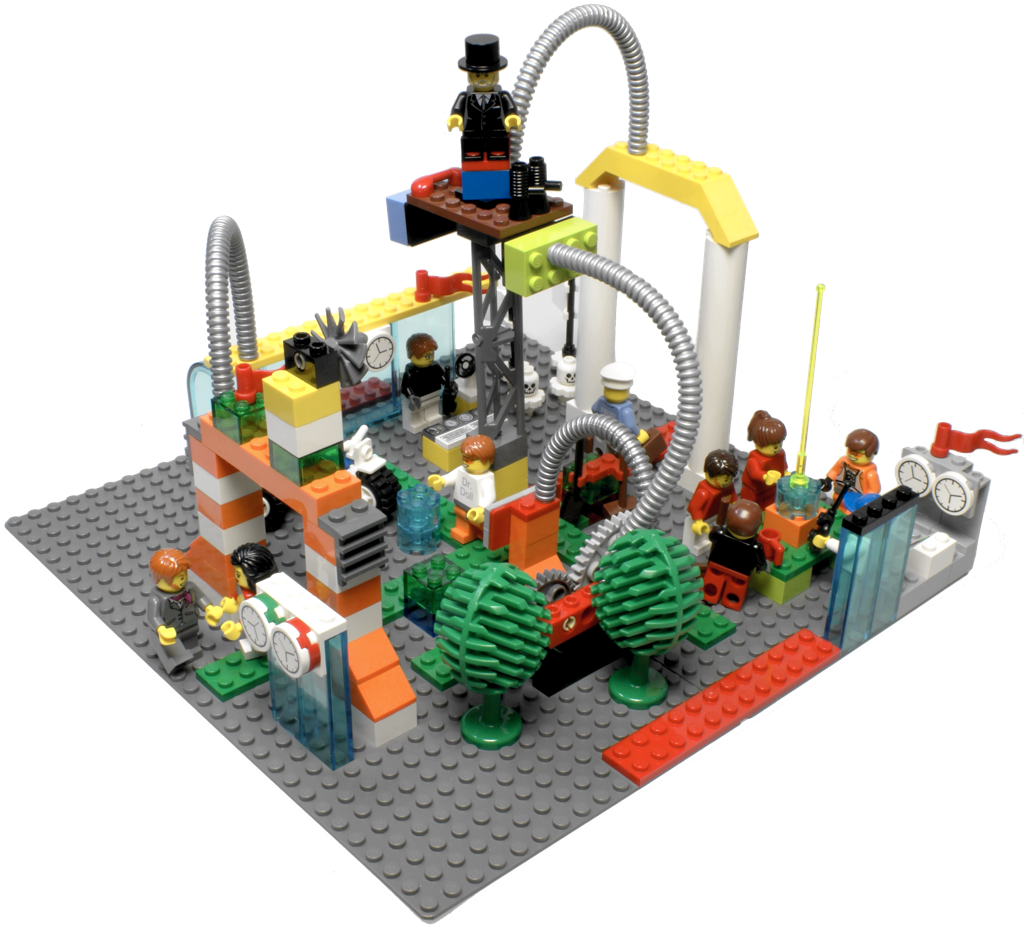
Please check out this article for further information.
6. Next Step: Definition of Playgrounds
Now it is time to define your strategy as your way to realise your "Picture of the Future". One of the next steps in this context is to use this picture as a reference point to derive so called "playgrounds" and to create and prioritise ideas as well as upcoming innovation projects in a portfolio matrix (x: distance to success, y: strategic fit). A "Picture of the Future" can spark ideas with setting out the strategic ambition and tapping in the creativity of all people in the company. These ideas and projects are then supposed to be executed in a Business Design manner to build the future incrementally.
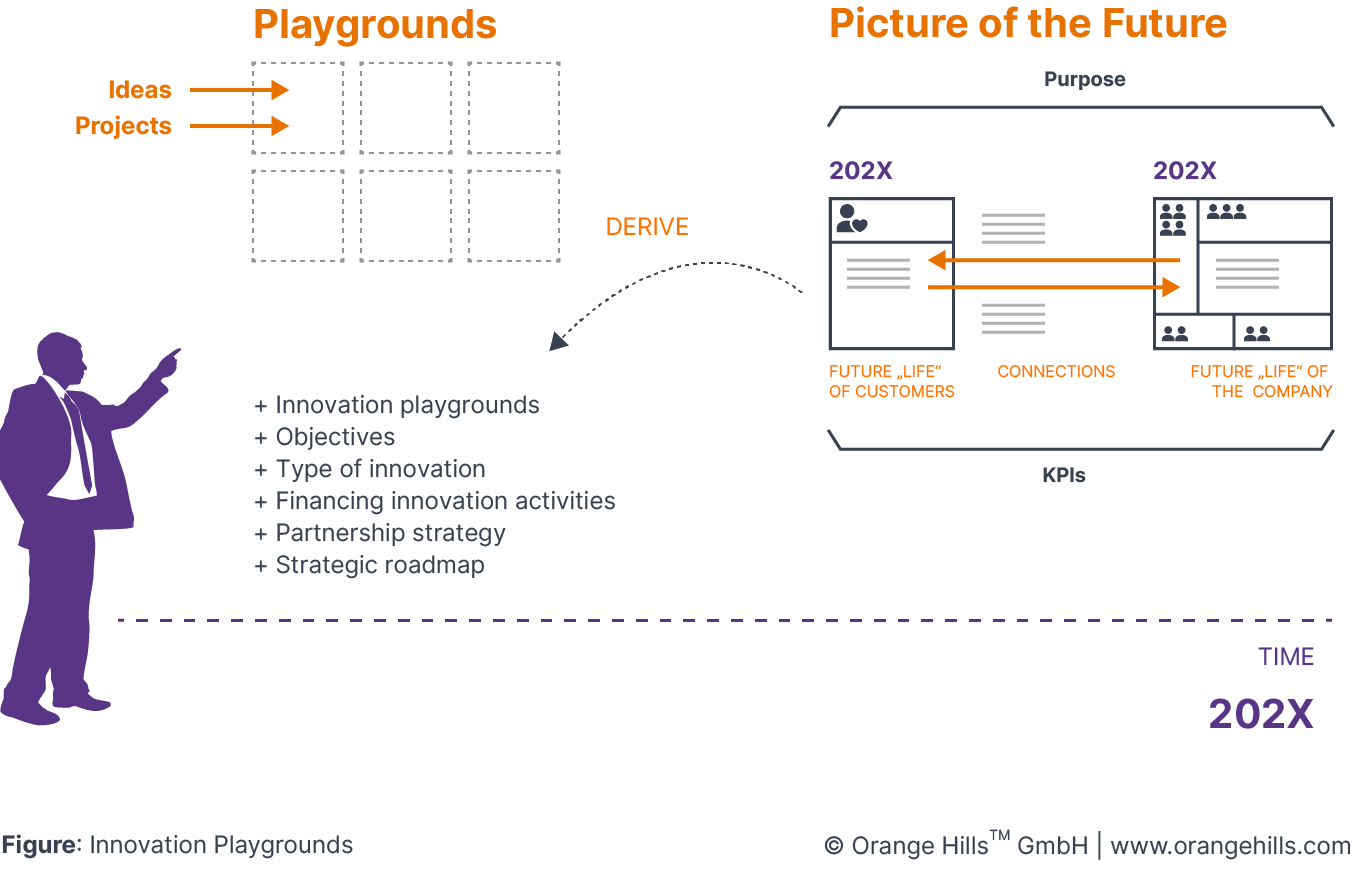
Playgrounds are framed spaces in which you aim to innovate. They are always derived from the "Picture of the Future" and can be defined around new technologies, trends, new customers or even new skills of your organisation. Examples are:
"New products for young families following circular economy principles"
"New platform-based solutions around democratising our data for the greater public good"
"Technologies that might help us design more sustainable products and save energy, waste and water in our production process”
And finally, the loop is closed to ideation, our Business Design sprints and the preparation needed to kick-off real-life projects.
1 "Sustainability" is one of these modern buzz words that requires a more precise definition: For us, "sustainability" means the operational approach of a business to meet its goals without impeding future generations to meet their needs and desires. "ESG" (= Environmental, Social, and Governance), in contrast, represents a framework to assess sustainability initiatives using metrics and benchmarks.
